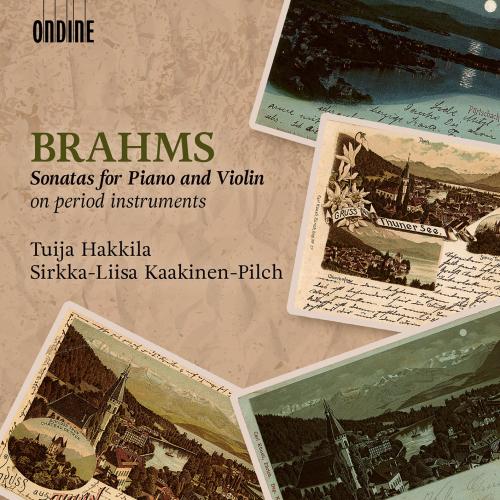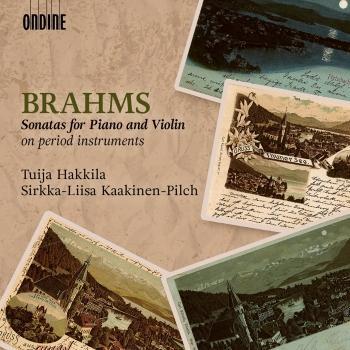
Brahms: Sonatas for Piano & Violin on Period Instruments Tuija Hakkila & Sirkka-Liisa Kaakinen-Pilch
Album info
Album-Release:
2018
HRA-Release:
13.04.2018
Label: Ondine
Genre: Classical
Subgenre: Chamber Music
Artist: Tuija Hakkila & Sirkka-Liisa Kaakinen-Pilch
Composer: Johannes Brahms (1833-1897)
Album including Album cover Booklet (PDF)
- Johannes Brahms (1833-1897): 5 Lieder, Op. 105:
- 1 No. 4, Auf dem Kirchhofe (Arr. for Violin & Piano) 02:44
- Violin Sonata No. 2 in A Major, Op. 100:
- 2 I. Allegro amabile 08:00
- 3 II. Andante tranquillo - Vivace 06:21
- 4 III. Allegro grazioso quasi andante 05:09
- 5 Lieder, Op. 105:
- 5 No. 1, Wie Melodien zieht es mir (Arr. for Violin & Piano) 01:41
- Violin Sonata No. 3 in D Minor, Op. 108:
- 6 I. Allegro 07:53
- 7 II. Adagio 04:07
- 8 III. Un poco presto e con sentimento 02:57
- 9 IV. Presto agitato 05:58
- 8 Lieder und Gesänge, Op. 59:
- 10 No. 3, Regenlied (Arr. for Violin & Piano) 04:23
- Violin Sonata No. 1 in G Major, Op. 78 "Regen":
- 11 I. Vivace ma non troppo 10:14
- 12 II. Adagio 07:01
- 13 III. Allegro molto moderato 08:19
Info for Brahms: Sonatas for Piano & Violin on Period Instruments
This album by Finnish duo partners Tuija Hakkila and Sirkka-Liisa Kaakinen-Pilch features Johannes Brahms’ Violin Sonatas played on period instruments. These three sonatas by Brahms form a cornerstone of chamber music repertoire for violin. When Brahms’s Sonata for piano and violin in G major op. 78, ostensibly his first, was published, it was actually the composer’s fourth venture in this genre as far as we know. Brahms began writing Sonata in G major when he had returned from Italy and travelled to the lake district of Pörtschach – a location where “the air is so full of melodies that one has to take care not to step on them.” The major work that Brahms completed that summer was the Violin Concerto. Before completing the manuscript of the Sonata, Brahms’ godson Felix died with tuberculosis. Brahms sent Clara Schumann a letter on the back of which he had copied out the first 25 measures of the Adagio in the Sonata in G major. “If you play this very slowly, you may appreciate more clearly than I could ever express in words the warmth with which I think of you and Felix – even of his violin, which has now fallen silent.” Pianist Tuija Hakkila holds a senior position in piano music at the Sibelius Academy and earned a Doctor of Music degree in 2005. She also taught at the Royal Danish Conservatory in Copenhagen from 2005 through 2008. In 2014 she was appointed Professor of Piano Music at the Sibelius Academy. Kaakinen-Pilch has been active in several orchestras and ensembles, and has also worked for over a decade as leader of the Collegium Vocale. Sirkka-Liisa Kaakinen-Pilch has recorded for Ondine - and solo violin works of the 16th and 17th centuries. Currently Kaakinen-Pilch works as Professor of early music at Cracow Music Academy.
Tuija Hakkila, piano
Sirkka-Liisa Kaakinen-Pilch, violin
Tuija Hakkila
studied at the Sibelius Academy with Liisa Pohjola and Eero Heinonen, and continued her studies at the Paris Conservatoire with Jacques Rouvier and Theodor Paraschivesco. She studied 20th century music with Claude Helffer in Paris and classical performance practices with Malcolm Bilson in the United States. Other influential teachers have included György Sebök, William Pleeth and Dmitri Bashkirov. She was a Fulbright Scholar at Columbia University in New York in 1985/86. Since 1987 she holds a senior position in piano music at the Sibelius Academy and earned a Doctor of Music degree in 2005. She also taught at the Royal Danish Conservatory in Copenhagen from 2005 through 2008. In 2014 she was appointed Professor of Piano Music at the Sibelius Academy.
She has been the Artistic Director of the Early Music Festival in Hämeenlinna, the Sibelius Academy Concert Series, Kaiho Festival in Espoo and Nurmes Summer Academy and Concerts.
She has performed as soloist, in chamber groups and as accompanist throughout Europe, in the United States, Japan, Indonesia, Africa and South America, and has made broadcasts in several countries. She has collaborated with eminent musicians like Karita Mattila, Vera Beths, Anner Bijlsma, Mikael Helasvuo, Sirkka-Liisa Kaakinen-Pilch, Anssi Karttunen, Alexei Lubimov and performed with conductors like Okko Kamu, Jukka-Pekka Saraste, Leif Segerstam and Sakari Oramo. Her repertoire ranges from Bach to contemporary music; She has developed her interest in period instrument performance, presenting classical and romantic programmes on period pianos. She works with a number of today's composers and is invited to give world premiere performances.
Tuija Hakkila's solo discography includes the complete cycle of Mozart keyboard sonatas for which she has won acclaim in the world press, a compilation of Jean Sibelius’ piano works, a recital of 20th century piano music and a world premiere recording of the early 19th century Finnish Lithander brothers' music. A CD with Kaija Saariaho’s chamber music for trio ensembles came out in fall 2012. In addition to this she has recorded Niccoló Castiglioni's chamber music, Haydn flute trios and Byström sonatas for piano and violin. In the repertoire for cello and piano her discography includes recitals of 20th century music, Gabriel Fauré's music and all Beethoven's works.
Sirkka-Liisa Kaakinen-Pilch
is an unusually versatile violinist. Though she plays music of every era, the emphasis in her repertoire is on the 17th to 19th centuries. She also plays the viola and viola d’amore and leads the orchestra or conducts from the front desk.
After completing her studies at the Sibelius Academy (Yoshiko Arai, Jouko Heikkilä, Kaija Saarikettu) Sirkka-Liisa Kaakinen-Pilch has studied, among others, under Ana Chumachenko and Baroque violin with Monica Hugget and Lucy van Dael.
Kaakinen-Pilch has been active in several orchestras and ensembles, including Avanti!, Finnish Baroque Orchestra, Helsinki Baroque Orchestra, Battalia, Orchestra of the 18th Century (Frans Brüggen), La Petite Bande (Sigiswald Kuijken), Amsterdam Baroque Orchestra (Ton Koopman), Concerto Copenhagen (Lars-Ulrik Mortensen), Orchestre des Chams-Elysëes (Philippe Herreweghe). She has also worked for over a decade as leader of the Collegium Vocale (Philippe Herreweghe). Kaakinen-Pilch is nowadays in great demand as a leader of countless renowned early music ensembles and orchestras, performing music of the Baroque and of the Classical period.
Her solo repertoire includes such works as the 16 Mystery Sonatas by Biber, the Bach Solo Sonatas and Partitas, and solo violin works of the 16th and 17th centuries.
Kaakinen-Pilch has been a Professor of chamber music at Stavanger University, and a Professor of early music at the Royal Danish Academy of Music and the Bremen Institute of Arts. Currently Kaakinen-Pilch works as Professor of early music at Cracow Music Academy and teaches violin at the Tampere University of Applied Sciences. She is also a teacher of Baroque violin at the Sibelius Academy, works as an instructor for the European Union Baroque Orchestra and teaches in several master classes.
Ondine released two CDs by Sirkka-Liisa Kaakinen-Pilch during autumn 2013: Sonatas and Partitas by J. S. Bach for violin solo and Orchestral Suites by Ch. Graupner. On this second CD she is leading the orchestra and playing viola d’amore as one of the soloists. In 2014 two further recordings were released: one with Trio Sonatas by Ch. Graupner (viola d’amore) and a double CD with H. I. F. 15 Biber’s Mystery Sonatas. Together with Tuija Hakkila she has recorded the Violin Sonatas of Thomas Byström. Her most recent recording with Ch. Graupner’s Epiphany Cantatas was released in December 2017. In this recording she is leading the Kirchheimer BachConsort and playing viola d’amore.
Booklet for Brahms: Sonatas for Piano & Violin on Period Instruments









